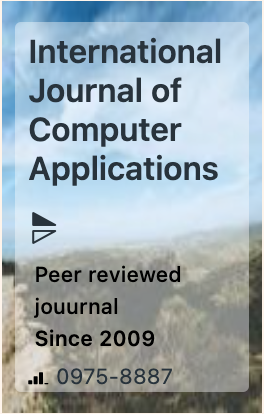The week's pick
Random Articles
Reseach Article
A Systematic Review of Machine Learning Models for Cardiac Disease Prediction
| International Journal of Computer Applications |
| Foundation of Computer Science (FCS), NY, USA |
| Volume 186 - Number 63 |
| Year of Publication: 2025 |
| Authors: Sunanda Budihal, Sheetalrani R. Kawale |
 10.5120/ijca2025924439
10.5120/ijca2025924439
|
Sunanda Budihal, Sheetalrani R. Kawale . A Systematic Review of Machine Learning Models for Cardiac Disease Prediction. International Journal of Computer Applications. 186, 63 ( Jan 2025), 27-33. DOI=10.5120/ijca2025924439
Abstract
Heart disease is one of the leading causes of mortality worldwide, making its early detection and prediction crucial for saving lives. Machine learning (ML) algorithms have the potential to revolutionize the healthcare system by enhancing diagnostic accuracy and improving patient outcomes. This study reviews previous research that applied Deep Learning (DL) and ML techniques to predict heart disease. From the study it has seen that most of the work have used supervised ML algorithms, which includes Support Vector Machines (SVM), Gradient Boosting Classifier (GB), Decision Trees (DT), Random Forest (RF), and Logistic Regression (LR), have been employed on the UCI Machine Learning Repository (Heart) dataset to predict cardiac conditions. The accuracy of these algorithms varies, with studies reporting success rates between 88% and 95%. This review explores the factors influencing these outcomes, contributing to a better understanding of ML-based heart disease prediction models.
References
- The Cardiovascular study in India. [Online]. Available: https://www.statista.com/study/86148/cardiovascular-disease-in-india/. Accessed: Jan. 28, 2024.
- A. F. A. Iswisi, O. Karan, and J. Rahebi, “Diagnosis of Multiple Sclerosis Disease in Brain Magnetic Resonance Imaging Based on the Harris Hawks Optimization Algorithm,” BioMed Research International, vol. 2021, pp. 1–12, Dec. 2021, doi: 10.1155/2021/3248834.
- H. Al-Safi, J. Munilla and J. Rahebi, "Harris Hawks Optimization (HHO) Algorithm based on Artificial Neural Network for Heart Disease Diagnosis," 2021 IEEE International Conference on Mobile Networks and Wireless Communications (ICMNWC), Tumkur, Karnataka, India, 2021, pp. 1-5, doi: 10.1109/ICMNWC52512.2021.9688348.
- T. Nguyen and Z. (Amy) Wang, “Cardiovascular Screening and Early Detection of Heart Disease in Adults With Chronic Kidney Disease,” The Journal for Nurse Practitioners, vol. 15, no. 1, pp. 34–40, Jan. 2019, doi: 10.1016/j.nurpra.2018.08.004.
- R. Liu, C. Ren, M. Fu, Z. Chu, and J. Guo, “Platelet Detection Based on Improved YOLO_v3,” Cyborg and Bionic Systems, vol. 2022, pp. 1–9, Sep. 2022, doi: 10.34133/2022/9780569.
- A. A. Mohamed, Aybaba Hançerlioğullari, Javad Rahebi, M. K. Ray, and S. Roy, “Colon Disease Diagnosis with Convolutional Neural Network and Grasshopper Optimization Algorithm,” Diagnostics, vol. 13, no. 10, pp. 1728–1728, May 2023, doi: 10.3390/diagnostics13101728.
- J. Rahebi, “Fishier mantis optimiser: a swarm intelligence algorithm for clustering images of COVID-19 pandemic,” International Journal of Nanotechnology, vol. 20, no. 1/2/3/4, pp. 25–49, 2023, doi: 10.1504/ijnt.2023.131111.
- A. Shalchi and Javad Rahebi, “Human retinal optic disc detection with grasshopper optimization algorithm,” Multimedia Tools and Applications, vol. 81, no. 17, pp. 24937–24955, Mar. 2022, doi: 10.1007/s11042-022-12838-8.
- R. Sameni and G. D. Clifford, “A Review of Fetal ECG Signal Processing Issues and Promising Directions,” The Open Pacing, Electrophysiology & Therapy Journal, vol. 3, pp. 4-20, 2010, doi: 10.2174/1876536x01003010004.
- H. Al-Safi, J. Munilla, and J. Rahebi, “Patient privacy in smart cities by blockchain technology and feature selection with Harris Hawks Optimization (HHO) algorithm and machine learning,” Multimedia Tools and Applications, Feb. 2022, doi: 10.1007/s11042-022-12164-z.
- J. Zou, Q. Li, S. Yang, J. Zheng, Z. Peng, and T. Pei, “A dynamic multiobjective evolutionary algorithm based on a dynamic evolutionary environment model,” Swarm and Evolutionary Computation, vol. 44, pp. 247–259, Feb. 2019, doi: 10.1016/j.swevo.2018.03.010.
- E. K. P. Chong and S. H. Zak, An Introduction to Optimization. Hoboken, NJ, USA: John Wiley & Sons, 2004.
- T. Rashid, Make Your Own Neural Network. Scotts Valley, CA, USA: CreateSpace Independent Publishing Platform, 2016.
- J. Anderson, L. Rainie, and A. Luchsinger, “Artificial intelligence and the future of humans,” Pew Research Center, vol. 10, pp. 12, 2018.
- “Identification of Cardiovascular Diseases Using Machine Learning | Semantic Scholar.” [Online]. Available: https://www.semanticscholar.org.
- K. Purushottam, K. Saxena, and R. Sharma, “Efficient Heart Disease Prediction System,” Procedia Computer Science, vol. 85, pp. 962–969, 2016, doi: 10.1016/j.procs.2016.05.288.
- M. Shouman, T. Turner, and R. Stocker, “Using Decision Tree for Diagnosing Heart Disease Patients,” Proceedings of the 9-th Australasian Data Mining Conference (AusDM'11), Ballarat, Australia, vol. 121, pp. 23-29, 2011.
- E. Maini, B. Venkateswarlu, B. Maini, and D. Marwaha, “Machine learning–based heart disease prediction system for Indian population: An exploratory study done in South India,” Medical Journal Armed Forces India, Jan. 2021, doi: 10.1016/j.mjafi.2020.10.013.
- M. E. Shipe, S. A. Deppen, F. Farjah, and E. L. Grogan, “Developing prediction models for clinical use using logistic regression: an overview,” Journal of Thoracic Disease, vol. 11, no. S4, pp. S574–S584, Mar. 2019, doi: 10.21037/jtd.2019.01.25.
- V. Radpour and F. S. Gharehchopogh, “A Novel Hybrid Binary Farmland Fertility Algorithm with Naïve Bayes for Diagnosis of Heart Disease,” Sakarya University Journal of Computer and Information Sciences, vol. 5, no. 1, pp. 90–103, Apr. 2022, doi: 10.35377/saucis...978409.
- R. TR, U. K. Lilhore, P. M, S. Simaiya, A. Kaur, and M. Hamdi, “Predictive Analysis of Heart Diseases with Machine Learning Approaches,” Malaysian Journal of Computer Science, pp. 132–148, Mar. 2022, doi: 10.22452/mjcs.sp2022no1.10.
- 22. I. K. A. Enriko, M. Suryanegara, and D. Gunawan, “Heart disease prediction system using k-Nearest neighbor algorithm with simplified patient’s health parameters,” Journal of Telecommunication, Electronic and Computer Engineering, Dec. 2016.
- “Top 6 Machine Learning Classification Algorithms,” GeeksforGeeks, Feb. 26, 2024. https://www.geeksforgeeks.org/top-6-machine-learning-algorithms-for-classification/ Accessed: Jan. 28, 2024.
- S. García, S. Ramírez-Gallego, J. Luengo, J. M. Benítez, and F. Herrera, “Big data preprocessing: methods and prospects,” Big Data Analytics, vol. 1, no. 1, Nov. 2016, doi: 10.1186/s41044-016-0014-0.
- A. Garg, B. Sharma, and R. Khan, “Heart disease prediction using machine learning techniques,” IOP Conference Series: Materials Science and Engineering, vol. 1022, p. 012046, Jan. 2021, doi: 10.1088/1757-899x/1022/1/012046.
- M. Kavitha, G. Gnaneswar, R. Dinesh, Y. R. Sai and R. S. Suraj, "Heart Disease Prediction using Hybrid machine Learning Model," 2021 6th International Conference on Inventive Computation Technologies (ICICT), Coimbatore, India, 2021, pp. 1329-1333, doi: 10.1109/ICICT50816.2021.9358597.
- A. A. Ahdal, M. Rakhra, S. Badotra and T. Fadhaeel, "An integrated Machine Learning Techniques for Accurate Heart Disease Prediction," 2022 International Mobile and Embedded Technology Conference (MECON), Noida, India, 2022, pp. 594-598, doi: 10.1109/MECON53876.2022.9752342.
- G. N. Ahmad, H. Fatima, S. Ullah, A. Salah Saidi and Imdadullah, "Efficient Medical Diagnosis of Human Heart Diseases Using Machine Learning Techniques With and Without GridSearchCV," in IEEE Access, vol. 10, pp. 80151-80173, 2022, doi: 10.1109/ACCESS.2022.3165792.
- K. K. Baseer, S. B. A. Nas, S. Dharani, S. Sravani, P. Yashwanth and P. Jyothirmai, "Medical Diagnosis of Human Heart Diseases with and without Hyperparameter tuning through Machine Learning," 2023 7th International Conference on Computing Methodologies and Communication (ICCMC), Erode, India, 2023, pp. 1-8, doi: 10.1109/ICCMC56507.2023.10084156.
- M. S. Manoj, K. Madhuri, K. Anusha and K. U. Sree, "Design and Analysis of Heart Attack Prediction System Using ML," 2023 IEEE International Conference on Integrated Circuits and Communication Systems (ICICACS), Raichur, India, 2023, pp. 01-06, doi: 10.1109/ICICACS57338.2023.10099819.
- A. Khan, M. Qureshi, M. Daniyal, and K. Tawiah, “A Novel Study on Machine Learning Algorithm-Based Cardiovascular Disease Prediction,” Health & Social Care in the Community, vol. 2023, p. e1406060, Feb. 2023, doi: 10.1155/2023/1406060.
- N. Narayanan and None Jayashree, “Implementation of Efficient Machine Learning Techniques for Prediction of Cardiac Disease using SMOTE,” Procedia Computer Science, vol. 233, pp. 558–569, Jan. 2024, doi: 10.1016/j.procs.2024.03.245.
- R. Hoque, None Masum Billah, None Amit Debnath, S. Hossain, and N. Bin, “Heart Disease Prediction using SVM,” International Journal of Science and Research Archive, vol. 11, no. 2, pp. 412–420, Mar. 2024, doi: 10.30574/ijsra.2024.11.2.0435.
- Y. Rimal, Siddhartha Paudel, N. Sharma, and Abeer Alsadoon, “Machine learning model matters its accuracy: a comparative study of ensemble learning and AutoML using heart disease prediction,” Multimedia Tools and Applications, vol. 83, no. 12, pp. 35025–35042, Sep. 2023, doi: 10.1007/s11042-023-16380-z.
- D. M. K. Selvi, J. Aswini, C. Balakrishnan, K. Suganya, B. G. Sheena and S. S. R, "Revolutionizing Cardiovascular Care: The Role of AI, ML, and DL in Early Heart Disease Prediction and Treatment," 2024 International Conference on Electronics, Computing, Communication and Control Technology (ICECCC), Bengaluru, India, 2024, pp. 1-6, doi: 10.1109/ICECCC61767.2024.10593941.
- “World Health Statistics 2021,” Who.int, 2021. https://www.who.int/publications/b/58471 (accessed Jan. 28, 2025).
- A. Kumar Dubey, K. Choudhary, and R. Sharma, “Predicting Heart Disease Based on Influential Features with Machine Learning,” Intelligent Automation & Soft Computing, vol. 30, no. 3, pp. 929–943, 2021, doi: 10.32604/iasc.2021.018382.
Index Terms
Keywords

